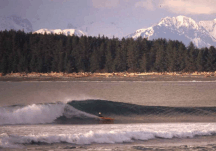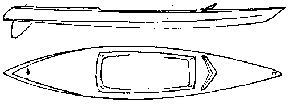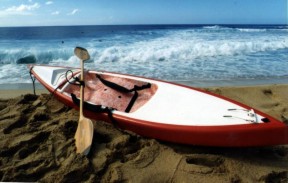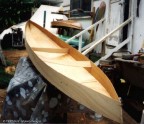Sit-on-topKayaking.com's Designers & Innovators of Sit-on-top Kayaks
An Interview with
|
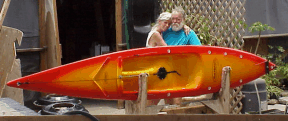 |
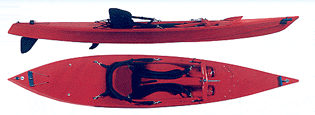 |
"I believe The Cobra Wave Witch is a breakthrough design for the mass market. It is elegant, it paddles and surfs like its composite sisters and yet is inexpensive. It can be used by a novice right out of the box, and is already proving to be popular for women because of its small size and lightweight. Incidentally, the design is not a one-trick-pony; it is a capable small sea kayak as well as a surf machine. Judy paddles her Witchlet 10-20 miles at a time on a fairly regular basis in the open water off Oahu." |
The Interview:
|
"My notebooks were filled with boat designs as well as hypersonic aircraft and spaceships..." SOTK: "Where are your roots? How long have you been designing? What got you started designing kayaks?" HUNT: |
My notebooks were filled with boat designs as well as hypersonic aircraft and spaceships and I devoured the writings of Atkins, Chapelle and the Herreschoffs."
|
"I thought it would be possible to design a boat that would surf better than the Niemier design, and paddle better than the Shane." "My first kayak was a stringer and canvas Greenland style boat built around 1961 for use around Lanikai, here on Oahu. I got into sit-on-top design after a long detour through outrigger canoes, multi-hulls and bigger boats, construction, Hang-gliding, and back into surfing in the early '80s where I saw the Shane wave skis out in the line up. |
SOTK: "Were you inspired by other kayak designers and if so who?"
HUNT:
"Chapelle's "Skin
and Bark Boats of North America" is a wonderful reference and source
of inspiration. The early fiberglass Ocean Kayak designed by Tim Neimier
and built by Mike Crips got me thinking about
|
kayaks again in the early eighties, and the Shane Wave
Skis gave me another shove in that direction.
Having already been impressed with the original Ocean Kayak as a sit-on-top cruiser, I thought it would be possible to design a boat that would surf better than the Niemier design, and paddle better than the Shane. The first attempt was too small, but the second try worked really well and was the basis for the 12' 6" original Wave Witch." |
"I like shaping surfboards freehand,
but for the boats I
usually start with small drawings..."
|
SOTK: "What materials or process do you prefer to use
in developing your designs?"
HUNT: |
"The original Wave Witch was developed using sheets of Clark polyurethane foam laid up in a female stringer mold. The inside is glassed and you then have a hollow and light blank to shape. Glass the outside, and you have a light and rigid prototype to play with. I still use this method to build most of my plugs, though once in a while I have shaped a block of poly bead foam. My first fiberglass boat was a 16' outrigger built in the 60's and I blew and hand shaped a polyurethane blank - the fumes almost did me in."
SOTK: "Any formal training in design? When? Where?"
"Actually, my college degree is in Marine Zoology..."
HUNT:
"Actually, my college
degree is in Marine Zoology, but I started in aeronautical engineering and
I've been designing stuff since grade school. I've designed and built a
submarine, a glider, geodesic domes, half a dozen houses, and a lot of
boats, including a couple of 45' multi-hulls and a 36' commercial fishing
boat."
SOTK: "What specific models can be attributed to your influence or design efforts?
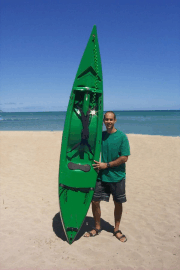 |
HUNT: "My kayak designs in fiberglass or composite construction currently in production include the Wave Witch Witchlet, the Wave Witch Horizon, and the recent update of the original "Classic" Wave Witch. Recently Cobra Kayaks has introduced the "Cobra Wave Witch" in rotomolded linear polyethylene. Several years ago I built a few racing boats called the "Cheetah". One of these, a 35lbs foam-core epoxy and kevlar sit-in version, was successfully paddled through the Northwest Passage by Martin Leonard III." SOTK: "What do you feel or what have others said may be your most important contribution to the evolution of the sit-on-top?" |
HUNT:
"Beauty. The design of a family of boats that successfully combine
excellent in-the curl surfing ability with paddling speed and stability.
The boats are all very forgiving and easy for the novice; yet offer excellent performance in most conditions. The use of a foot bar controlled under-hull spade rudder as standard equipment is a fairly major innovation."
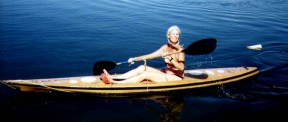 |
SOTK: "Is there a kayak you have some special regard for and why?" HUNT: |
| The prototype was so light and cute that I made one for myself, one for my wife, Judy, and then we sent two to the 1995 World Kayak Surfing Contest in Costa Rica where, ridden by Spinnaker Wyss-Johnsen and Martin Leonard III, they won both Men's and Women's events in the sit-on-top class. |  |
(The B.C.U. then holding the next World competition, changed the rules, eliminating fiberglass or composite boats from competing in the sit-on-top class.)"
"My boats are elegant without being gimmicky."
|
SOTK: "What role do you see your designs playing in the future of sit-on-top kayaking?" HUNT: "Hopefully they will bring a little simplicity and taste back to kayak design. I think many of the boats now in production try to do too much and as a consequence are cluttered and often ugly and slow. |
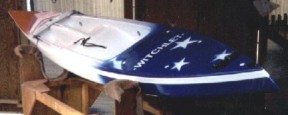 |
My boats are
elegant without being gimmicky. Their form follows their function, and
they are proof that you can combine paddling ease and speed with a planing
hull that behaves well on a wave. The use of an under-hull spade rudder on
a kayak is also innovative and at this point controversial, but it works
so well that we will probably see it used more widely.
SOTK: "What kind of paddling/boating do you enjoy doing most
these days and what is your favorite model to do it in? Favorite places to
go?"
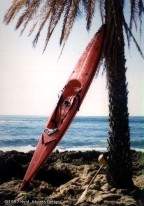 |
HUNT:
"My paddling is pretty much limited to surfing, cruising is too much like work. I prefer a new "Classic" for "big" waves (I'm too old and chicken for stuff over 8' or so), as it is very fast, but I like the little Witchlet for hot-dog surfing in small and medium size waves. It turns on a dime and I can hold it down in serious whitewater. I surf a relatively unknown break out at Sand Island Park here on Oahu. The few surfers who know about the spot are tolerant of an old guy on a boat and get stoked when the old fart shreds." |
SOTK: "What is your slant on the growing popularity of the
sit-on-top kayak?"
HUNT:
"The
sit-on-top concept is so inherently user-friendly that its continued
popularity is assured. I came to kayaking through the back door - I surfed
boards. The idea of being inside a kayak in the surf spooked me. If it
were not for the sit-on-top concept I wouldn't have gotten involved in
kayak surfing at all. As it is, I have to admit I've not yet learned to
roll, although doing so in a Wave Witch is very easy. It is so easy to get
back into a Witch that it is not an issue. I have a brand new Kimo Green
tanker surfboard that doesn't get used because surfing the kayaks is so
easy. I can catch a whole lot more waves with the boat, and even small
stuff is overhead."
"The sit-on-top concept is so inherently user-friendly
that its continued popularity is assured."
SOTK: "What other projects have you been up to?"
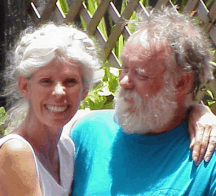 |
HUNT: "Judy and I spend a lot of time just maintaining the shop with its population of cats, fish, bufos and plants. We've developed some optional equipment for the Cobra Wave Witch - breakwater moldings and flexible cast urethane rudders. Believe it or not, I'm working with an e-group of designers and engineers and eventually I'm hoping to help build a reusable single stage to orbit spaceship. The same techniques used to build lightweight kayaks can be applied to lightweight fuel tanks and aero shells. If NASA won't do it, we will. Lots of us old hippies are still space cadets." |
FOR MORE INFORMATION ABOUT HUNT JOHNSEN'S DESIGNS
VISIT
HIS WEBSITE AT:
http://www.huntjohnsendesigns.com/
OR
DEALER IN HAWAII:
http://www.gobananaskayaks.com/hjd/hjd.htm
FOR
INFORMATION ABOUT PURCHASING COBRA'S ROTOMOLDED WAVE WITCH VISIT:
http://www.cobrakayaks.com/
BOOKS BY AUTHORS MENTIONED IN THIS ARTICLE CAN BE PURCHASED ON AMAZON.COM BY USING THE FOLLOWING LINKS:
The Bark Canoes and Skin Boats of North America by Howard I. Chapelle
Boatbuilding : A Complete Handbook of Wooden
Boat
Construction by Howard I. Chapelle
The Sailor's Handbook by Halsey C. Herreshoff
American Small Sailing Craft by Howard I. Chapelle
Guide to the Haffenreffer-Herreshoff Collection : The Design Records of the Herreshoff Manufacturing Company, Bristol, Rhode Island by Kurt Hasselbalch
READ & SIGN OUR GUESTBOOK!


